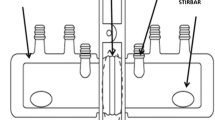Abstract
Purpose. The relationship between rat intestinal permeability (Papp) of a range of hydrophilic probe molecules and probe geometry was examined.
Methods. Molecules studied included mannitol, the polyethylene glycols (PEGs) 400, 900, and 4000, the dextran conjugated dye Texas Red® (MW 3000) and the polysaccharide inulin (MW 5500). Molecular surface area, volume and cross-sectional diameter for each probe were determined from computer models. The effect of the bile salt sodium cholate, and bile salt: fatty acid mixed micelles on probe intestinal permeability was also studied.
Results. Of the size parameters tested, cross-sectional diameter correlated best with log intestinal permeability. The data was fitted to a relationship of the form Papp = P0 app exp(−Krca) where rca is the molecular cross sectional radius, P0 app and K are constants. Estimates of equivalent pore radii (R) were also made; the use of rca giving the most reasonable estimate of R. Absorption of all probes was enhanced by both simple and mixed micellar systems.
Conclusions. For large hydrophilic probes, and possibly protein drugs, cross sectional diameter is a more important size parameter than volume based values for evaluating size-related retarded absorption. The relationship established may be used as a tool to assess absorption enhancement potential of excipients.
Similar content being viewed by others
REFERENCES
J. Kreuter, Adv. Drug Del. Rev. 7:71–86 (1991).
J. R. Pappenheimer and K. R. Reiss, J. Membr. Biol. 100:123–136 (1987).
T. Y. Ma, D. Hollander, R. A. Erickson, H. Truong and P. Krugliak, Am J. Physiol. 260:G669–G676 (1991).
F. E. Curry. In E. M. Renkin and C. C. Michel (eds.), Handbook of Physiology, Section 2, The Cardovascular System, Vol. IV, Microcirculation. Am. Physiol. Soc., Bethsada, MD, 1984, pp. 309–374.
A. K. Solomon, J. Gen. Physiol. 51:335s–364s (1968).
V. S. Chadwick, S. F. Phillips and A. F. Hoffman, Gastroenterol. 73:241–246 (1977).
D. Hollander, D. Ricketts and C. A. R. Boyd, Can. J. Gastroenterol. 2 (suppl. A):35A–38A (1988).
I. Komiya, K. Y. Park, A. Kamani, N. F. H. Ho and W. I. Higuchi, Int. J. Pharm. 4:249–262 (1980).
A. Adson, T. J. Raub, P. S. Burton, C. L. Barsuhn, A. R. Hilgers, K. L. Audus and N. F. H. Ho, J. Pharm. Sci. 83:1529–1535 (1994).
P. G. Lunn, C. A. Northrop and A. J. Northrop, Clin. Chim. Acta 183:163–170 (1989).
I. M. Kinahan and M. R. Smyth, J. Chromatog. 565:297–307 (1991).
M. Cereijido. In M. Cereijido (ed.), Tight Junctions, CRC Press, Boca Raton, FL, 1993, pp. 1–13.
J. L. Madara, D. Barenberg and S. Carlson, J. Cell Biol. 102:2125–2136 (1986).
K. H. Soergel, Gastroenterol. 105:1247–1250 (1993).
N. F. H. Ho, J. Y. Park, P. F. Ni, and W. I. Higuchi, In W. Crouthamel and A. C. Sarapu (eds.), Animal Models for Oral Drug Delivery in Man, Am. Pharm. Assoc. Washington, D.C. 1983, pp. 27–106.
Author information
Authors and Affiliations
Rights and permissions
About this article
Cite this article
Lane, M.E., O'Driscoll, C.M. & Corrigan, O.I. The Relationship Between Rat Intestinal Permeability and Hydrophilic Probe Size. Pharm Res 13, 1554–1558 (1996). https://doi.org/10.1023/A:1016091915733
Issue Date:
DOI: https://doi.org/10.1023/A:1016091915733




